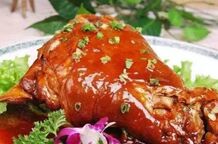“硬菜”引发南北大讨论,你家乡的硬菜是什么?
|
There have been many controversies over differences in diet between the North and the South in China. For example, a northern Chinese may wonder why their southern fellows must have stir-fried vegetables as the last dish for a meal, while the southerner may be surprised to know that people from north always hoard cabbages before winter.
hoard:贮藏 Recently, different understandings of ying dishes caused another round discussion on the internet. Chinese Name:Ying dish Function: To satisfy a craving for delicious food Attributes: Meat in large chunks and ingredients in bulk Cooking Requirements: Mom's cooking / Highly rated restaurant's cooking Eating Methods: To gobble and devour Applicable Environments: Necessary to northern Chinese In northern China, ying dishes refer to those which are distinctive and delicious enough to show your sincerity when you entertain guests. Dishes with abundant meat and varieties of fish are often considered as ying dishes which are usually served in basins rather than plates. Some said that ying dishes are quite common in the North, which are usually made of purely beef, lamb and pork and other kinds of meat, and must look amazing in terms of presentation. For most southern Chinese, however, ying dishes are quite unfamiliar. Seven out of eight styles of Chinese cuisine originate from southern parts of China, which are eye-dazzling with various kinds of cooking methods. Ying dishes in South China are not only numerous in variety, but also in perfect combination of colors, smells and tastes. In Guangdong province for example, soup are usually stewed for several hours with chunks of vegetables or seafood rather than chunks of meat, is often considered as the ying dish and attached great importance. chunks:厚块,大块 It is said that soup should always be served first on the table with great expectations and people will comment after trying. A restaurant which is unable to provide satisfactory soup is often considered a failure. Except for the heated discussion, people from different provinces also willingly and proudly shared the ying dishes in their hometown. |









